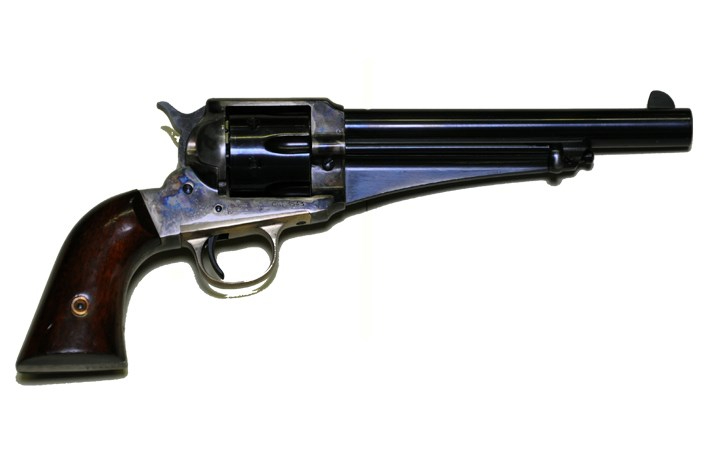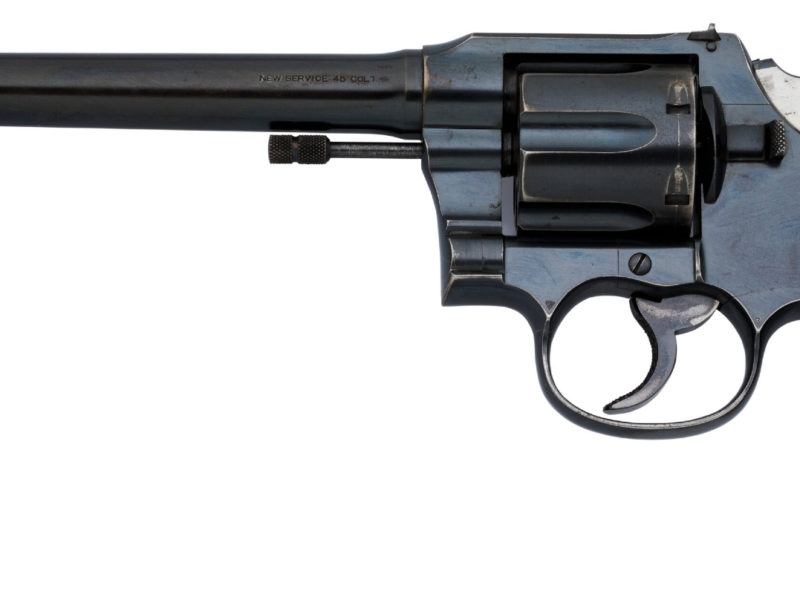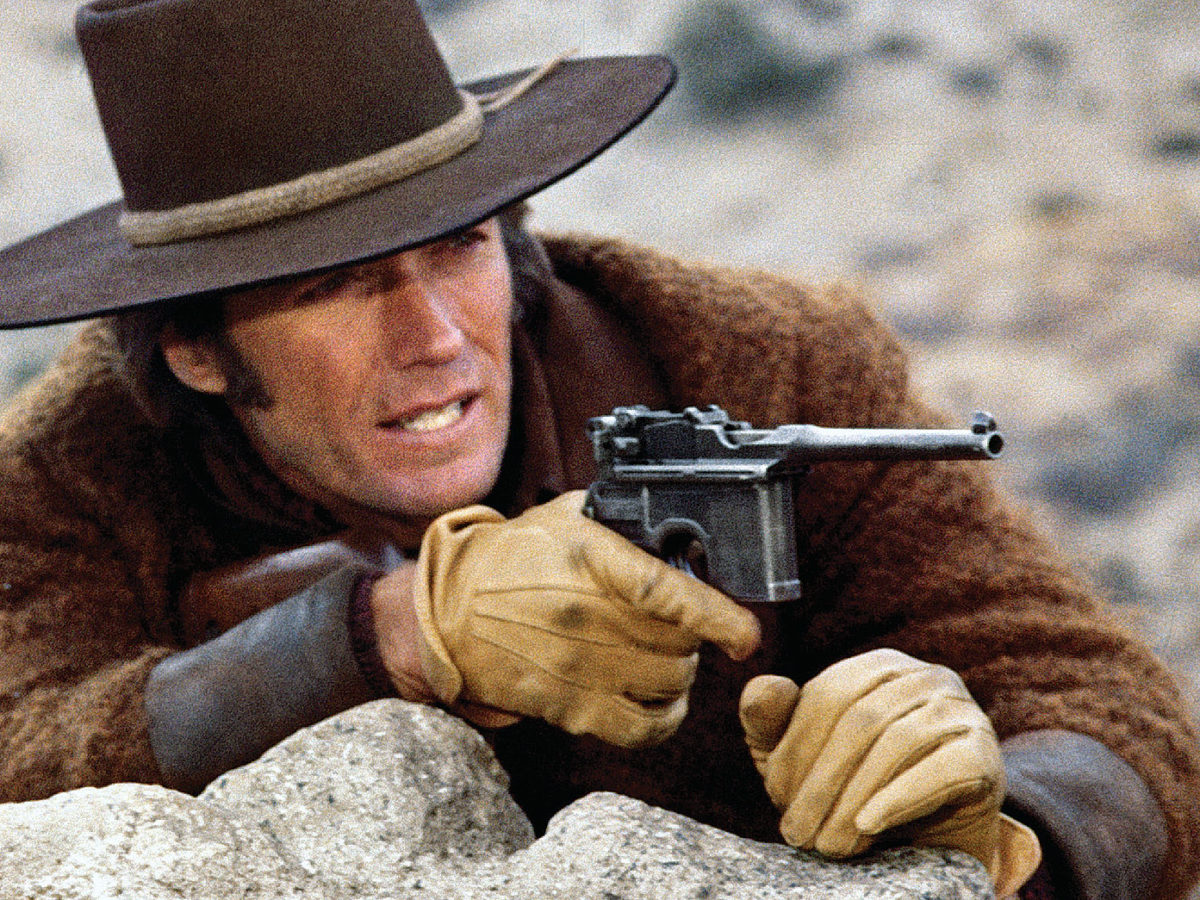Colt, Winchester and Sharps head the list of gun manufacturers who developed iconic firearms during the shoot ’em up period of the Old West. But there is one other name that should not be buried in their trail dust: Remington, which had the distinction of being the oldest gun manufacturer of the 19th century.
Here’s how Remington revolvers became a mainstay among scofflaws of the Wild West.
History of the Remington Family
Born in Suffield, Connecticut, on Oct. 28, 1793, forge owner Eliphalet Remington II began cranking out quality, handmade barrels for flintlock rifles in 1816. By 1848, he and eldest son, Philo, were making complete single-shot cap-and-ball rifles, and Eliphalet soon brought his other sons, Sam and Eliphalet III, into the company. When Sam Colt’s exclusive patents on cap-and-ball revolvers expired in 1857, E. Remington & Sons’ cap-and-ball revolvers became one of Colt’s biggest competitors.
Eliphalet died in 1861, so he didn’t see the rapid expansion of the Remington manufacturing facilities created by the huge demand for revolvers during the Civil War. But when that wartime volume ended, those overbuilt facilities sat mostly unused. Financial problems soon plagued the company, even though production of its world-famous single-shot rolling block cartridge rifles was keeping it afloat. So it struggled into the cartridge era sustained by the instant popularity in 1866 of the now-iconic .41 rimfire, over-and-under two-shot derringer.
Although Smith & Wesson’s exclusive patents on cartridge revolvers expired in 1869, it wasn’t able to develop its top-break, .44-caliber single-action No. 3 American Model six-gun until 1870. And Colt began production of its legendary solid-frame, .45-caliber Single Action Army Model six-gun in 1873.
remington Model 1875
Slowed by its financial problems, Remington in 1875 brought out its own solid-frame, .44-caliber single-action six-gun, now known as the Model 1875, to compete with Smith & Wesson and Colt. At first glance the Remington appears to be a clone of the Colt, but the Remington’s backstrap and trigger strap are integral with its frame, while those straps are separate components on the Colt. The Model 1875 Remington Single Action Army is also readily distinguishable from the Colt Single Action Army by the “web” beneath its ejector housing — a holdover from the days of Remington’s cap-and-ball Army revolver, which had a similar web to strengthen the loading lever.
The standard barrel length of the Model 1875 was 7½ inches, with a few made in 5¾-inch lengths. Its calibers were .44 Remington centerfire, .44–40 and a few in .45 Long Colt. Walnut grips and blued finish were standard. As with the Colts, nickel, silver or gold plating was optional, as were pearl or ivory grips, plain or carved. Any quality of engraving was also available. The advertised price hovered at $12.50 for blued guns and $13.50 for plated ones. The barrel marking on all Model 1875s was “E. REMINGTON & SONS, ILION, N.Y.” Remington made the gun from 1875 to 1889.
Recommended for you
No Longer a Family Operation
Even Remington’s big six-shooter couldn’t save the family company, though. In 1888 Thomas Gray Bennett (son-in-law of Oliver Winchester of Winchester rifle fame) and New York gun dealer Marcellus Hartley (of Hartley and Graham) took control of E. Remington & Sons and renamed it Remington Arms Co.
As part of his attempt to revive the company financially, Hartley continued to produce the Model 1875 Single Action Army as the Model 1890. The Model 1890 was basically the same gun as the Model 1875 with two major differences: The web underneath the ejector housing was eliminated and the barrel marking was changed to “REMINGTON ARMS CO., ILION, N.Y.” Besides the standard 7½-inch barrel length, it also came in a 5½-inch length. Standard grips were hard rubber, with the monogram RM embossed at the top. Caliber was .44-40 only. Otherwise, the same options as in the Model 1875 were available. The company manufactured the Model 1890 from 1891 to 1896.
Finding old Remington REvolvers Today
In 1959, I was scrounging for old guns in the coastal town of Lompoc, California, and I bought a Model 1890 Remington off the wall of an old downtown bar. The gun had original pearl grips, an original 5½-inch barrel and some nickel finish still showing under a light coat of rust. It had been found at the base of a cliff on a beach around the turn of the century, and it obviously had never been cleaned or altered in any way. But it had the Model 1875 “E. REMINGTON & SONS” barrel marking on it instead of the Model 1890 “REMINGTON ARMS CO.” marking.
Coincidentally, an antique gun dealer in Sunnyvale, California, had just purchased a large collection of Model 1875 and Model 1890 Remington single-actions in excellent condition, and he let me spend a day closely inspecting them. Sure enough, about a half-dozen of his Model 1890 revolvers also had the “E. REMINGTON & SONS” barrel marking on them instead of the “REMINGTON ARMS CO.” marking. And it was obvious that none of them had been altered, either.
Knowing that Colt had continued to make complete Single Action Army Model revolvers from their parts bins years after having manufactured those parts, I came to the conclusion Remington had done the same when the company went bankrupt in 1888. It apparently had used some leftover Model 1875 barrels on the first Model 1890s it put together to be sold.
I published this information in a long letter in the May 1962 issue of The Gun Report magazine. Subsequent research by Remington scholars has proved that my initial conclusion was correct, and collectors now refer to this hybrid Model 1890 Remington single-action with the Model 1875 barrel address as the “Model 1888 Transition Model.” It is estimated the company produced fewer than 1,000 of these Model 1888s.’
GET HISTORY’S GREATEST TALES—RIGHT IN YOUR INBOX
Subscribe to our Historynet Now! newsletter for the best of the past, delivered every Wednesday.
REmingtons and Outlaws
Colt made about 148,000 Single Action Army revolvers from 1875 to 1896. Remington produced some 28,000 to 33,000 single-actions (25,000 to 30,000 Model 1875s, 1,000 Model 1888s and 2,000 Model 1890s) before ceasing production of the guns in 1896. And so, compared with Colt, the production of the Remingtons looks downright anemic, even allowing that many Colts went to the U.S. military and not to civilians.
Yet many Model 1875 and Model 1890 Remingtons saw use on the frontier, perhaps because they were cheaper to buy than the Colts and Smith & Wessons and, therefore, saw more use by the riff-raff of the West.
Frank and Jesse James both owned and used Model 1875s, at least two of which still exist: Frank’s No. 5116 and Jesse’s No. 559. An outlaw known as “Redtop” Callihan was wearing a Model 1875 Remington when he was gunned down in Bodie, Calif., in 1892 after allegedly killing six men with it. Businessman R.H. Bain went to Alaska with his Model 1875 Remington and reportedly shot two claim jumpers with it; its original belt, with holster, is stamped “KENNEDY HARDWARE, ANCHORAGE ALAS.” In 1883, the U.S. Department of the Interior bought 639 nickel-plated Model 1875s for distribution to Indian Police on the Western reservations. And the Mexican government is known to have purchased about 1,000 of them.
But it was too little, too late for the Remington single-action revolvers. As Wyoming cowboy Frank Rollinson wrote in his memoirs: “We all carried guns. …. We all preferred the Colt single-action six-shooter.”
Originally published in the October 2011 issue of Wild West.
historynet magazines
Our 9 best-selling history titles feature in-depth storytelling and iconic imagery to engage and inform on the people, the wars, and the events that shaped America and the world.










